We are now into month ten of COVID-19 vaccinations globally, and seven months into the Australian inoculation process, 4 weeks since our last update.
On 22-Feb: there were 186mln doses administered worldwide across 82 different countries, at a run-rate of 6.34mln doses per day
On 22-Mar: there were 410mln doses administered worldwide across 132 different countries, at a run-rate of 9.96mln doses per day
On 19-Apr: there were 848mln doses administered worldwide across 154 different countries, at a run-rate of 17.9mln doses per day
On 17-May: there were 1.38bln doses administered worldwide across 176 different countries, at a run-rate of 22.5mln doses per day
On 16-Jun: there were 2.42 billion doses administered worldwide across 180 different countries, at a run-rate of 35.1mln doses per day
On 3-Aug: there were 4.16 billion doses administered worldwide, across 180 countries at a run-rate of 42mln doses per day.
On 3-Sep: there has been 5.39 billion doses administered worldwide, across 183 countries, at a run-date of 41mln doses per day (ever so slightly slowing down).
That’s about 35.1% of the global population receiving at least 1 dose of the vaccine.
Visually, the USA, China, NZ, Australia have noticeably improved on their vaccination rollout this last month, however, also worth noting that “wealthy” nations are vaccinating TWENTY times faster than poorer nations. We can see this where poorer African, Asian and South American nations are lighter green colouring.
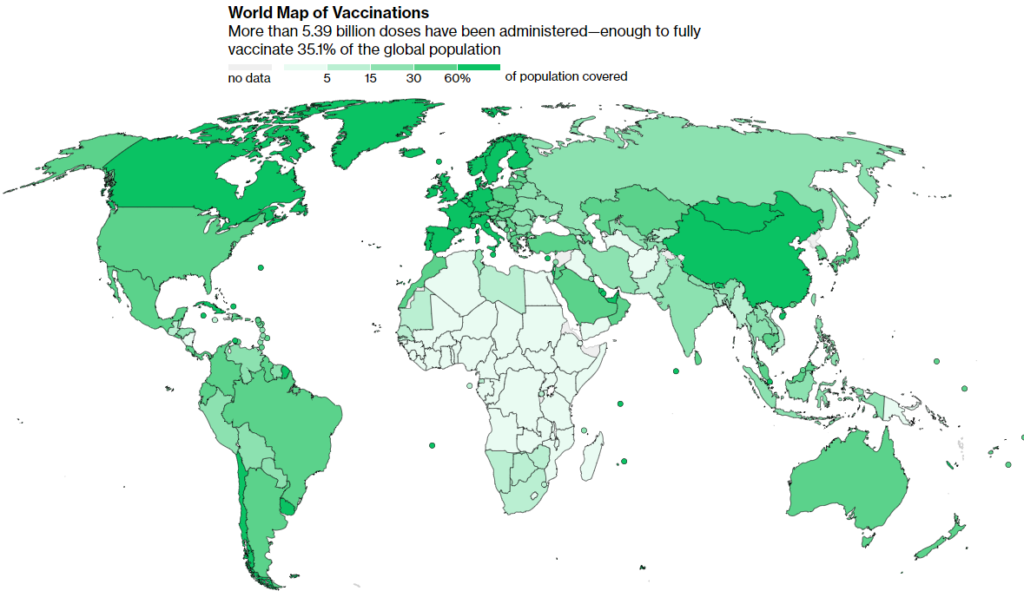
Source: Bloomberg
Life Returning to Normal
Aggregate vaccination doses and the proportion of society fully vaccinated remains the key indicator for when life may return to normal – the old normal – where country’s borders may be more open than present, and we reach “herd immunity” where a critical mass of 70%+ of the global population is immunised to the current strains of COVID-19 through vaccinations or a build-up of anti-bodies through exposure to the virus.
I know we write this every month, but evidence shows most people would prefer the vaccination approach, though small portions of populations remain hesitant or sceptical.
At the current rate of ~40.99 million doses per day, it will take another 5 months to cover 75% of the global population and achieve herd immunity.
Pandemic of the Unvaccinated
We thoroughly broached the topic “pandemic of the unvaccinated” but believe it’s worth re-producing the below graphic to share how demonstrably better it is to be vaccinated and come in contact with COVID, than to be unvaccinated.
This is the case where higher vaccination rates have been highly effective at preventing severe cases of COVID that lead to hospitalization and death.
According to the latest data from the USA, UK, Israel and even to an extent what’s being published by NSW Health authorities, vaccines have dramatically reduced the severe side effects of the virus.
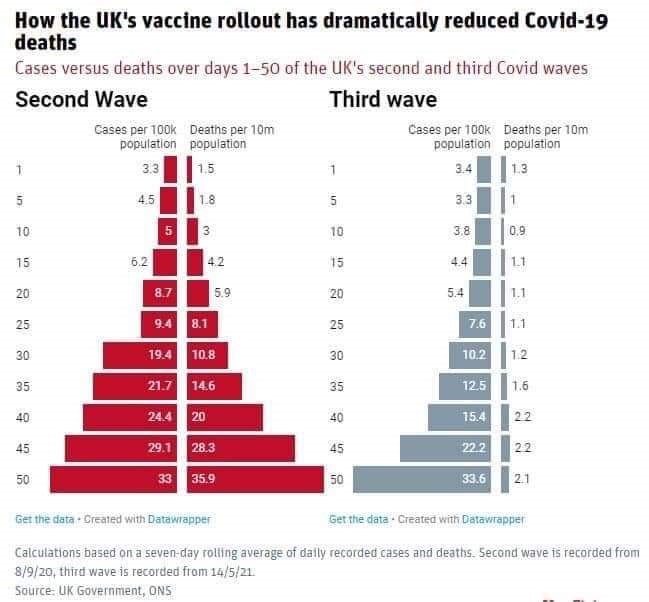
Australia’s Vaccination Progress
We’re pleased to review the Australian progress and note that we’ve quickly ramped up our own vaccination progress, slightly faster than expected for August, largely due to NSW and VIC lockdowns and their large populations seeking vaccines.
Last month we had only seen ~12.4 million vaccinations to Aussies, below our target of 25 million at the time, where on 2-September we’ve just passed 20 million vaccinations.
It’s important to distinguish people having received one (of two) doses, from those “fully” vaccinated, having received both doses, as that’s the critical milestone for when we’ll reach our 70% and 80% government thresholds to allow reopening.
So far, only 7.5 million Australians have been fully vaccinated, or 29.03% of the population, placing us fourth last in OECD nation vaccination rollout (35/38).
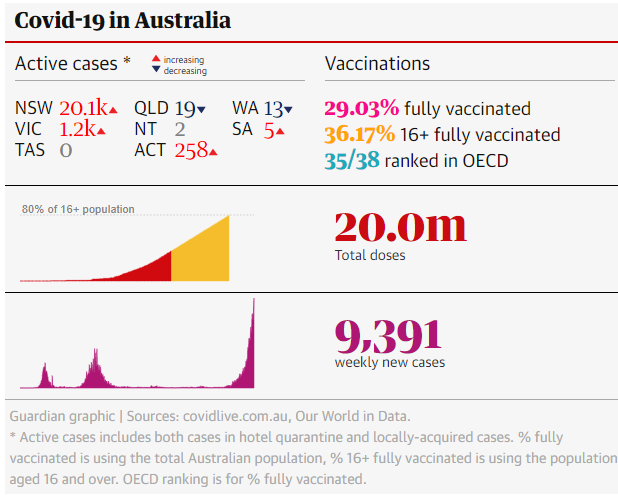
Reopening Australia
A new metric that’s worth being aware of is the tracking of SECOND doses, where we’re currently averaging 121k second doses per day.
At this rate, we’ll vaccinate 80% of our 16+ population in mid to late November, and likely see easing of restrictions across the country.
I’d like to highlight the fragility within this framework, where we’ll be seeking to reopen at a time when ~25% of the total population are unvaccinated, and susceptible.
Moreover, depending on you age, gender, ethnicity, personal health, and access to medical services; you’ll also be affected to a varying degree as well.
We can see this in the state-by-state progressions, where QLD, WA, NT, VIC and SA will take longer to reach the 70% and 80% milestones than ACT, NSW, TAS.
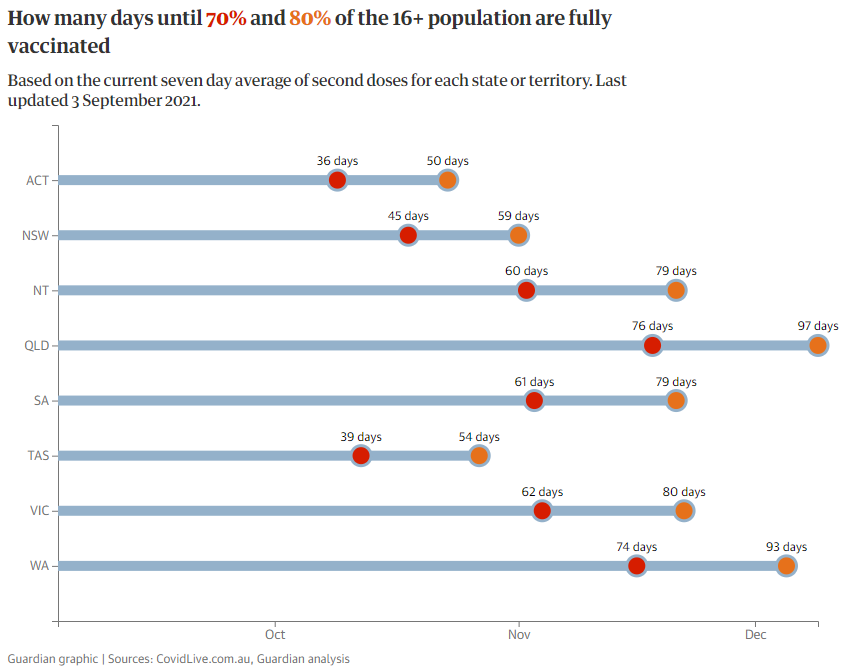
But also, by age bracket:
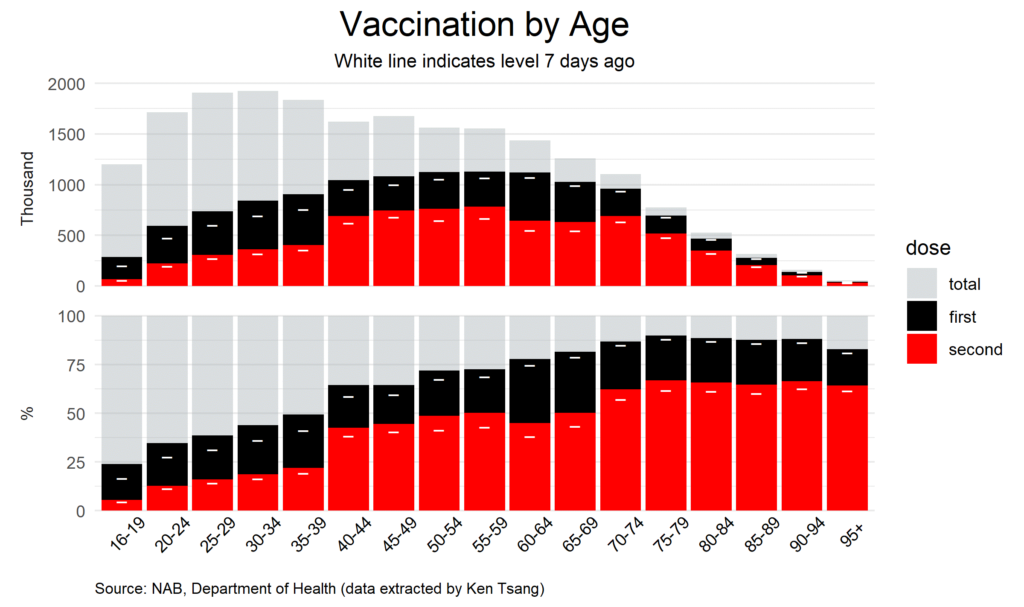
Vaccinating Younger Aussies
The Australian Technical Advisory Group on Immunisation (ATAGI) is now recommending vaccinating against COVID-19 for all individuals from 12 years of age, though as a lesser priority to older Australians.
There are 1.2 million people aged 12-15 in Australia, where adding them to the rollout would only take ~10 days at the current vaccination rate, minimally slowing down reopening.
If ATAGI were able to add 5–11-year-olds at a later date, that would add an additional 2.3 million Australians.
In aggregate, 5–15-year-olds would add 3.5 million people to the rollout, requiring 7 million doses of vaccinate, which should still be within our expected 2021 mRNA supply and all of these minors would be able to receive either Pfizer or Moderna.
Noting, we’re due to receive 41 million Pfizer and 10 million Moderna by the end of the year.
Vaccination Hesitancy
The remaining factor I’ve been looking into has been the number of Aussies that are vaccine hesitant or firmly against, as residual demographic that may be susceptible to infection.
Not to mention there will likely be some individuals who for some medical reason cannot receive a vaccination, but so far, the number has been very low (near 0).
The best data I’ve found so far (via a NAB research paper) was produced by the Melbourne Institute, which shows that just over 10% of Australians are not willing to be vaccinated, while those that are merely hesitant, is another ~6-7% of the total population.
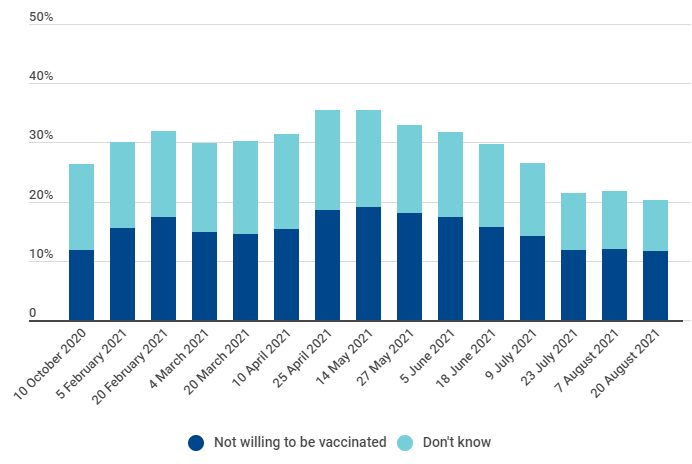
Source: Melbourne Institute
In total, that’s less than 20% of the total population, which should provide no impediment to us reaching our national 80% vaccination goal in December, so that we’re able to (more or less) get back to normal by 2022!
The views expressed in this article are the views of the stated author as at the date published and are subject to change based on markets and other conditions. Past performance is not a reliable indicator of future performance. Mason Stevens is only providing general advice in providing this information. You should consider this information, along with all your other investments and strategies when assessing the appropriateness of the information to your individual circumstances. Mason Stevens and its associates and their respective directors and other staff each declare that they may hold interests in securities and/or earn fees or other benefits from transactions arising as a result of information contained in this article.



